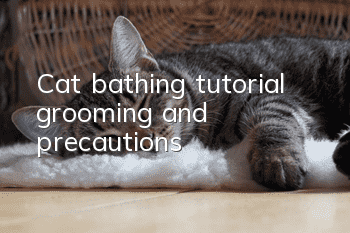Cat bathing tutorial, grooming and precautions

Cats love to be clean, but many kittens don’t like bathing. If you want to make it easy to bathe cats, you must train them from an early age and develop a good tacit understanding with their owners. However, different types of cats, especially cats with different coats, have different bathing methods. How to bathe your cat better?
1. Overcome cats’ natural dislike of bathing
1. Bath preparation supplies
Bath tub, bath towel, bath liquid (use one that is not irritating to the cat’s skin), comb (metal, wooden or plastic is acceptable, it is best to prepare one with fine teeth and one with sparse teeth), brush, absorbent cotton swab, Small tweezers, eye ointment, hair dryer, etc.
2. The water is deep and the temperature is moderate
If you have developed the habit of bathing since childhood, one person can complete it, but for naughty cats or cats that have not developed the habit of bathing, two people will be needed. The water depth is appropriate so that the kitten is not submerged. The best water temperature is between 30 and 35 degrees, as long as it feels mild.
3. Drops of scented bath liquid in the water
You can drop some bath liquid in the water. After making these preparations, slowly put the kitten into the bathtub and wash it in the order of its head, back neck, back and tail, abdomen and limbs.
4. Take a shower quickly
The action should be quick and completed in as short a time as possible. After changing the water and rinsing, immediately use a dry bath towel to absorb the water from the kitten's body. If it is a long-haired cat, it is not suitable to wipe it with a bath towel. It is best to use a hair dryer to comb and dry it.
2. Pay attention to pet cats when bathing
1. It is not advisable to bathe frequently
Usually 2-3 times a month. Because the oil on the cat's skin has a certain protective effect on the skin and fur, if it is used too frequently, a large amount of oil will be lost, which will easily make the kitten's hair brittle and reduce the skin elasticity, which may become a trigger for skin inflammation.
2. Keep the room warm
When taking a bath, the room should be kept warm, especially in winter to prevent the kitten from catching a cold. Before taking a bath, the kitten should also be allowed to perform slight activities to make the cat eliminate feces and urine.
3. Prevent water from entering eyes and ears
You can squeeze a little eye ointment into the cat's eyelids before taking a bath to prevent and protect the eyes. When bathing, be careful not to let water get into the cat's ears. After washing, you can use absorbent cotton swabs to absorb the water in the cat's external auditory canal.
4. Carefully clean the cat’s tail
Cats’ tails are easy to get dirty, especially male cats, which excrete secretions from the root of their tails, and their tails are often stained with dirt. This kind of dirt cannot be washed away with water. You can scrub it with a toothbrush dipped in bath liquid, and then rinse it with warm water.
5. Weaning is not suitable during pregnancy
Newly weaned kittens do notIt is advisable to take a bath. The kitten has just left the mother cat and its body's resistance is relatively weak, so it is easy to get sick. Cats should not be bathed in the later stages of pregnancy because bathing may cause miscarriage.
6. Pay attention to bathing in winter and summer
After taking a bath in summer, do not let the cat bask in a place with strong sunlight. This can easily cause the cat to suffer from heat stroke. After taking a bath in winter, to prevent the cat from catching cold, it is necessary to keep the cat warm in time to prevent the occurrence of diseases.
7. It is not appropriate to inject vaccines
Cats should not be bathed within 2 weeks after being vaccinated, because cats may have systemic or local reactions after being vaccinated, and bathing at this time may cause other types of diseases in cats.
3. There are many steps to take a bath for long-haired cats
1. Water slowly penetrates into the roots
Pour warm water into the bathtub, put the cat into the basin, let it stand, and then use the nozzle to shower it, so that the water slowly seeps into the hair roots. Do not pour water on the head. You can use gauze or towels dipped in water to give it. Wet little by little.
2. There is order from beginning to end
Apply the special shampoo on the head, neck, and chest in sequence, and then gently scrub it with your fingertips as if scratching an itch. After the special shampoo foams, wash the cat's butt and paws, as well as dirty places. Should be washed more carefully.
3. Rinse the foam thoroughly
After scrubbing, use the nozzle to rinse the neck, chest, tail, and head in order. When rinsing, pay attention to the appropriate water temperature, and be especially careful not to let the shampoo foam flow into the eyes and ears. Very dirty areas should be washed twice more.
4. Blow fluff and comb for smoothness
Use a hair dryer to blow dry the hair. When using the hair dryer, the order of blowing is to start from the buttocks and look towards the neck. This makes the hair fluffy. When blowing, the temperature should not be too high to avoid scorching the hair tips and burning the skin. After blow drying it is ready to be combed and brushed.
4. Short-haired cats can be wiped
1. Wipe gently with short hair
Because the hair is short, there is usually no need to force it to bathe. Just soak the towel with warm water, dry it, then wrap the towel around the cat and wipe it gently, then wipe it off with a dry towel, so that the dirt on the cat's coat can be removed.
2. Rub it along the hair two or three times
Dip your hands in water, first rub the cat's buttocks to the head against the fur 2-3 times, and then rub the cat's head, back, ribs, and abdomen along the fur to remove the dirt attached to the coat and the fallen coat. Hair removal. When finished, carefully dry the body with a dry towel.
3. Sort it out carefully
After wiping, use a clean brush to gently comb the entire body. Comb out particularly dirty areas more carefully. Cats have a special characteristic. They usually don’t like people.Touch its belly and heels, and comb these areas carefully and carefully.
In addition to the precautions mentioned above when bathing cats, you should also note that it is not suitable to bathe cats when they are very young or sick. At this time, their resistance is relatively weak and they are prone to illness.
- What should I do if my cat doesn’t like to drink water? There are tricks to make cats drink water!
- What are the common types of cat litter?
- What are the blood types of cats?
- Symptoms and causes of food allergies in pet cats
- Can cats shed hair if they eat egg yolks? What are the benefits of cats eating egg yolks?
- What happened if the one-month-old kitten vomited?
- Causes, symptoms and preventive measures of cat miscarriage
- When does a cat molar its teeth?
- What should you pay attention to when raising Jinjila kittens? How to feed Jinjila kittens!
- The list of the most expensive pet cats in the world is out, and the first one is too expensive to keep!



